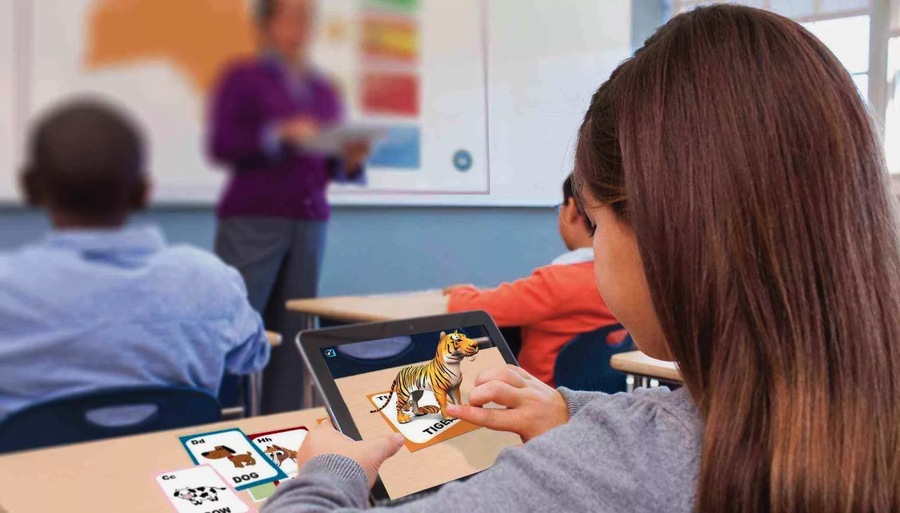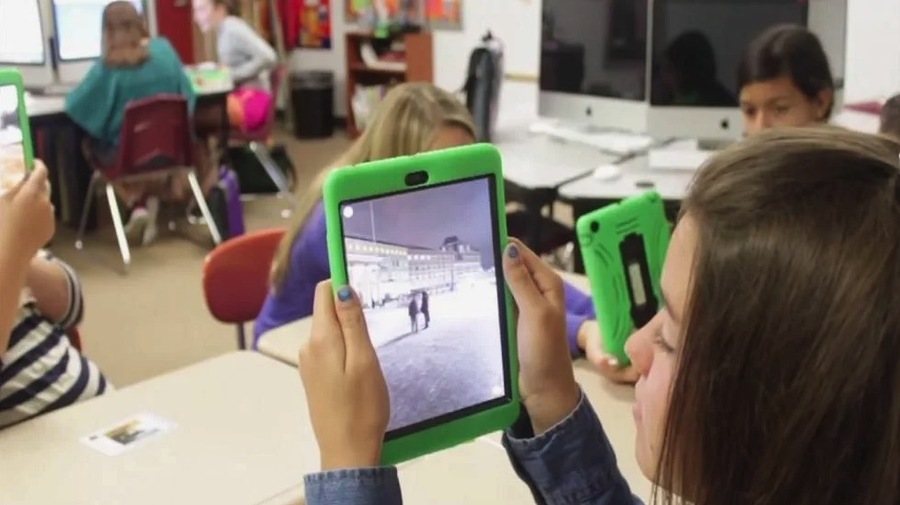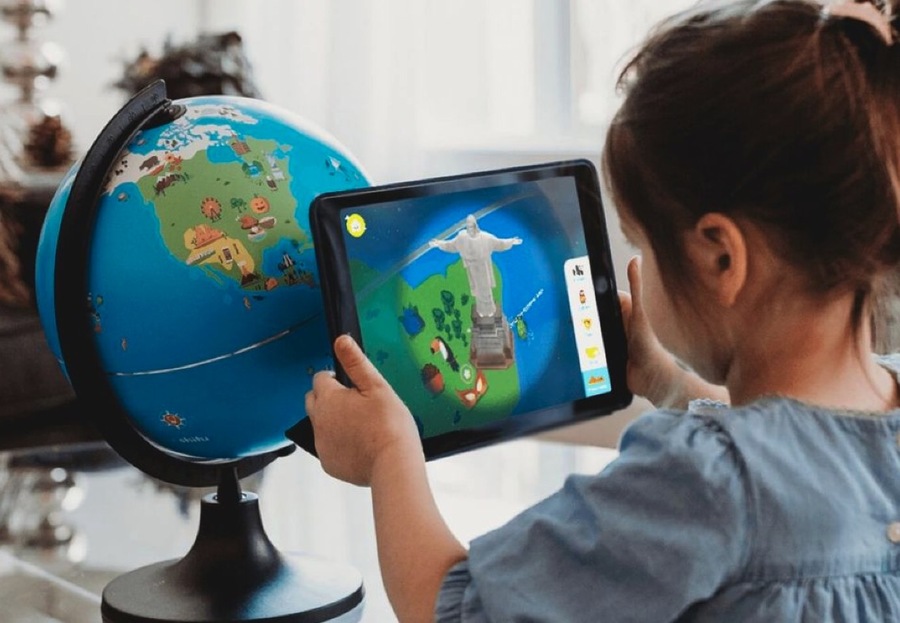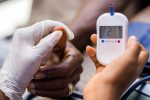Integrating Augmented Reality in School Curriculums

May 30, 2024
Technology is key in changing traditional teaching techniques in today’s ever-changing educational environment. Augmented Reality (AR) is one of the most exciting technological developments and can completely change how students interact with and learn about a wide range of disciplines. Augmented Reality (AR) produces immersive and interactive learning experiences that can greatly improve comprehension and retention by superimposing digital information onto the environment. With an emphasis on its use in Ajman schools, we examine the advantages and uses of augmented reality (AR) in improving interactive learning in disciplines like science, history, and geography in this blog.
The Power of Augmented Reality in Education
Augmented reality (AR) combines the real and virtual worlds to provide students with an innovative method of engaging with instructional materials. It is a perfect tool for teaching since it adds digital aspects to the actual world, unlike Virtual Reality (VR), which creates a false environment. With technology, learning may become more interactive, abstract ideas can become tangible, and engagement levels can increase.
Enhanced Engagement and Motivation
AR’s capacity to inspire and engage pupils is among its most important educational advantages. Conventional teaching approaches sometimes fail to hold students’ interest, particularly when it comes to subjects seen as dull or hard. On the other hand, AR makes learning a dynamic and engaging experience. With 3D models, animations, and interactive simulations that pique students’ attention and make studying enjoyable, an augmented reality app, for instance, may transform a textbook into a dynamic teaching tool.
According to University of Maryland research, pupils who used augmented reality (AR) for learning demonstrated a 33% higher level of engagement than those who used traditional approaches. This increased participation resulted in better knowledge and recall of the subject matter.

Real-World Applications in Science
AR integration have enormous benefits for science teaching. AR has the power to bring difficult-to-visualize scientific concepts to life. For example, students in private schools in Ajman can examine intricate 3D reconstructions of the human body using augmented reality applications such as 3D4Medical and Human Anatomy Atlas. Students may explore cross-sections, zoom in on certain organs, and understand the complex functions of many body systems with the help of these applications.
AR improves laboratory experiences as well. Equipment and safety limits are common in traditional labs. Thanks to augmented reality, students may conduct experiments, see chemical processes, and undertake virtual dissections without taking physical risks. This increases the range of experiments that may be carried out and permits repeated repetition, strengthening learning.
Bringing History to Life
With AR, history—sometimes perceived as a dry subject composed of dates and events—can become a vibrant and engaging subject. It is possible to bring historical events, objects, and locales to life, which makes studying history more interesting for pupils. Students may take virtual tours of historical landmarks and see historical events reenacted in Ajman private schools thanks to augmented reality applications like TimeLooper and HistoryView.
For instance, augmented reality (AR) experiences that let students tour the Giza Pyramids, closely study hieroglyphics, and engage with 3D replicas of artifacts might enhance a lecture on Ancient Egypt. Immersion learning opportunities like this help people appreciate and comprehend historical events and civilizations on a deeper level by making history tangible and unforgettable.
Interactive Geography Lessons
Another area where AR may significantly influence is geography teaching. It can be difficult to understand geographical ideas using static maps and diagrams, such as topography, climatic patterns, and tectonic processes. By producing interactive 3D models that students may examine, augmented reality (AR) brings these ideas to life.
AR applications such as JigSpace and Google Earth are utilized in Ajman private schools to give pupils interactive geography courses. These visually stimulating applications help kids investigate various terrains, track weather trends, and comprehend the effects of natural calamities. For example, students may better understand these intricate processes by simulating the movement of tectonic plates and seeing the creation of mountains and earthquakes.
AR has been effectively incorporated into schools’ curricula, proving its effectiveness in improving learning results. Here are a few noteworthy instances:
School Zuidhorn, Netherlands
The science curriculum at Zuidhorn School uses augmented reality (AR) applications to help students visualize difficult scientific ideas. Instructors who use augmented reality (AR) technologies say their pupils do better on tests and are more engaged.
China’s Tsinghua University High School
AR is being used in this school to teach geography and history. Students can study geographical elements in three dimensions and virtual field visits to historical locations. The school has noticed increased interest in certain courses and better retention.
Ajman’s City American School
City American School in Ajman has implemented AR to improve STEM instruction. Students may conduct virtual experiments, examine 3D representations of scientific phenomena, and participate in interactive classes that enhance learning through augmented reality (AR) apps.
Challenges
Even though augmented reality (AR) has many advantages for education, several issues must be resolved for it to be successfully implemented. Among them are:
Cost and Accessibility
Since augmented reality (AR) technology can be costly, not all schools have the funds to purchase AR hardware and software. To open AR to more schools, looking at affordable options and pursuing partnerships or financing is imperative.
Technical Expertise
Teachers must have the technical know-how and training to integrate AR effectively. Schools must invest in professional development to ensure that instructors are comfortable with AR technologies and can incorporate them into their courses.
Content Quality
Because AR material varies in quality, choosing resources and apps that meet educational requirements is critical. Working together with suppliers of instructional technology, schools may make sure that the augmented reality material is correct, pertinent, and interesting.
Data Privacy and Security
As technology is increasingly used in education, data security and privacy are becoming urgent issues. Schools need strong data protection procedures to secure student information and adhere to applicable legislation.

Future Outlook
With additional cutting-edge applications predicted to come from ongoing technological breakthroughs, augmented reality in education has a bright future. We can anticipate a greater uptake of AR gadgets in classrooms throughout the globe as they become more accessible and inexpensive. Future directions in AR education include the following:
Collaborative Learning
Using augmented reality (AR), students may collaborate on interactive projects and simulations. This strengthens problem-solving abilities and encourages collaboration.
Personalized Learning
AI and AR may be used to provide individualized learning experiences that are catered to each learner’s requirements and learning preferences. This guarantees that every student gets the assistance they require to achieve.
Remote Learning
The COVID-19 epidemic has brought attention to the crucial role of remote learning programs. Augmented reality (AR) can improve remote learning by offering accessible, immersive, and engaging experiences.
Lifelong Learning
AR can help with lifetime learning and go beyond K–12 education. Adults may use AR for training, skill development, and professional advancement.
Conclusion
Augmented reality is revolutionizing education through increased interactivity, effectiveness, and engagement. Like many other private schools worldwide, Ajman’s utilizes modern technology to improve curricula and give pupils immersive learning opportunities. AR can completely change how students learn and interact with instructional materials, from visualizing difficult scientific ideas to bringing history to life and examining geographical elements.
We must solve these issues and ensure that every kid benefits from augmented reality. Schools can establish a more engaging and productive learning environment by investing in augmented reality technology, offering professional development for teachers, and choosing top-notch material. The age of education is upon us, with it, countless opportunities to improve student learning and engagement.

Basketball fan, coffee addict, record lover, International Swiss style practitioner and ADC member. Working at the intersection of modernism and elegance to craft experiences that go beyond design. Currently living in New York City.





